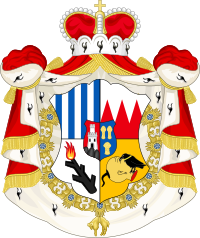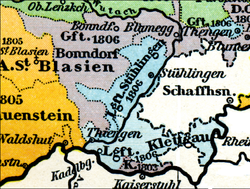Lordship of Schwarzenberg (Klettgau)
|
Territory in the Holy Roman Empire |
|
|---|---|
| Lordship of Schwarzenberg (Klettgau) | |
| coat of arms | |

|
|
| map | |

|
|
| Alternative names | princes of the Landgraviate of Klettgau |
| Arose from | Landgraviate of Klettgau |
| Form of rule | monarchy |
| Ruler / government | Prince |
| Today's region / s | DE-BW |
| Parliament | 1 curiate vote on the Swabian Count's Bank |
| Reich register | 60 guilders |
| Reichskreis | Swabian Empire |
| District council | 1 virile voice on the prince's bench |
| Capitals / residences | Tiengen |
| Dynasties | Schwarzenberg (Franconian-Bohemian noble family) |
| Denomination / Religions | Roman Catholic |
| Language / n | German |
| surface | 4 square miles or approx. 220 km² (1804) |
| Residents | 8,682 (1804) |
| Incorporated into | Mediatization 1806; |
| See also | Landgraviate of Klettgau |
Under the rule Schwarzenberg (as gefürstete Landgraviate Klettgau called) is the the house Schwarzenberg in the person of Prince Ferdinand zu Schwarzenberg in 1687 by the Count of Sulz inherited Landgraviate Klettgau , which in 1694 by Emperor Leopold I was raised to the princely Landgraviate. The sovereignty of the princes of Schwarzenberg ended in 1806 with mediatization ; the rulership of the von Schwarzenbergs ended in 1812 with the sale of the class and landlord rights to the Grand Duchy of Baden . The seat of rule was Tiengen Castle , and at times also Jestetten Castle .
Imperial legal position
The princes had no direct seat in the Reichsfürstenrat, but one on the Swabian count bank in the Reichsfürstenkollegium, d. H. the respective prince could only exert influence indirectly through the count bank - he had a curiate vote . The admission to the Imperial Princes' College recommended by the Emperor with its own seat and its own voice ( virile voice ) did not take place.
In Swabian Circle , however, Schwarzenberg was due Klettgau a Virilstimme on the prince Bank, but what you increasing the circle attack accept - that pay more money for the tasks of the Empire circle - had. In contemporary publications, the voice is usually called "Schwarzenberg because of Klettgau".
Independent of the Klettgau, the Schwarzenberg family had the 91st vote (virile vote) in the Imperial Council of Princes and a curate vote in the Franconian Counts' College because of the rule of Seinsheim since 1674.
coat of arms
The coat of arms of the Barons von Seinsheim (later named Schwarzenberg) originally consisted of a silver shield with blue stripes. In 1599 Count Adolf von Schwarzenberg added a Turkish head to his coat of arms with a raven pecking out its eyes.
In 1688, after the Sulzian inheritance, the princes of Schwarzenberg were given the right to use their title and to add the three red tips from the arms of the Counts of Sulz to the coat of arms. The burning torch represents the reign of Brandis; the heart shield shows a tower on a black mountain and three golden sheaves - the coat of arms of the actual Principality of Schwarzenberg.
The Schwarzenberg motto was "Nil Nisi Rectum", which means "either right or not at all".
The end of the Schwarzenberg rule in Klettgau
While the Napoleonic reorganization of the German southwest had already begun and the Landgraves of Klettgau had already lost their sovereignty over the places of Klettgau belonging to Zurich and Schaffhausen in 1801/03, the Schwarzenbergs were still negotiating a treaty with their Fürstenberg neighbors in 1806 to replace Fürstenberg rights in the Tiengen area.
In 1806, the Rhine Confederation Act brought about the mediatization of the Schwarzenberg rule, and sovereignty over the entire area fell to the Grand Duchy of Baden .
In 1812 Prince Joseph von Schwarzenberg also sold the civil rights and landlord rights to the Grand Duchy of Baden .
economy
Agriculture, animal husbandry and forestry formed the economic basis - there were no factories. There was little trade in the city of Tiengen.
The princes
The sovereigns carried the title "Prince of Schwarzenberg, Prince Count in Klettgau, Count of Sulz, Hereditary Court Judge of Rottweil of the Holy Roman Empire".
| Name (life data) | Reign | Remarks | |
|---|---|---|---|

|
Ferdinand zu Schwarzenberg (23 May 1652 - 22 October 1703) |
1687-1703 | married Maria Anna Countess von Sulz in 1674 and was able to inherit the landgraviate from this male line that had died out |

|
Adam zu Schwarzenberg (born September 25, 1680 - † June 11, 1732) |
1703-1732 | |

|
Joseph I. zu Schwarzenberg (December 15, 1722 - February 17, 1782) |
1732-1782 | 1766 issued "Inheritance and Law of the Duchy Landgraviate Klettgau including the lordships attached to it" |

|
Johann I. zu Schwarzenberg (born July 3, 1742 - † November 5, 1789) |
1782-1789 | |

|
Joseph II zu Schwarzenberg (June 27, 1769 - December 19, 1833) |
1789-1806 | he lost sovereignty in 1806; Sales of Castle Tiengen , Castle Willmendingen and Standesherrschaft on 19 July 1812 the House of Baden |
The domain of domination
The Landgraviate of Klettgau bordered in the north on the Principality of Fürstenberg ( Landgraviate Stühlingen ) and the Canton of Schaffhausen ; in the east to the canton of Zurich ; in the south to the Hochstift Konstanz ( Kaiserstuhl , Rötteln , Zurzach ) and in the west to the Upper Austrian county of Hauenstein .
It included the larger localities listed below. In total, the area around 1800 included the city of Tiengen, 11 parish villages and 30 other small villages with a total population of approx. 9,000.
| local community | Year of purchase | Remarks | coat of arms |
|---|---|---|---|
| Tiengen | 1687 | Inherited from the Counts of Sulz; see also Tiengen Castle , residence and seat of the Princely Schwarzenberg Upper Office; around 1800 approx. 1300 inhabitants |

|
| Jestetten | With today's district of Altenburg; around 1800 a parish village with around 700 inhabitants |

|
|
| Schwerzen | With the villages of Wutöschingen and Degernau , the rule of Willmendingen was at times disputed between Fürstenberg and Schwarzenberg. ( Horheim and Ofteringen were legally part of the Principality of Fürstenberg ) |

|
|
| Upper garlic rings | Unterlauchringen belonged to the Fürstenberg Landgraviate of Stühlingen; the lower jurisdiction, however, belonged to the Landgraviate of Klettgau. Oberlauchringen was subordinate to the Klettgau District Court . |

|
|
| Lottstetten | Parish village with approx. 600 inhabitants around 1800; the current districts of Balm and Nack also belonged to the Schwarzenberg lordship |

|
|
| Erzingen | Parish village with approx. 850 inhabitants around 1800 |

|
|
| Semolina | Parish village with approx. 1050 inhabitants around 1800 |

|
|
| Bechtersbohl | Today, Bechtersbohl forms together with Dangstetten, Kadelburg with Ettikon (also Kadolzburg; the Schwarzenberg rule only had high jurisdiction here), Küßnach, Reckingen and Rheinheim (parish village with approx. 900 inhabitants around 1800) the newly founded community Küssaberg in 1975 ; see also Küssaburg |

|
|
| Stetten | With Günzgen; Hohentengen itself belonged to the Hochstift Konstanz |

|
literature
- Dieter Stievermann: Lordship Schwarzenberg . In: Meinrad Schaab , Hansmartin Schwarzmaier (ed.) U. a .: Handbook of Baden-Württemberg History . Volume 2: The Territories in the Old Kingdom. Edited on behalf of the Commission for Historical Regional Studies in Baden-Württemberg . Klett-Cotta, Stuttgart 1995, ISBN 3-608-91466-8 , pp. 423-428.
- Phillip Ludwig Hermann Röder: Geographical Statistical-Topographical Lexicon of Swabia, Volume 1, Ulm 1800, Column 1139–1143
- Prince Joseph von Schwarzenberg . In: New Nekrolog der Deutschen Volume 11 (1833), Part 2, Weimar 1835, pp. 820f.
Individual references / comments
- ^ Georg Hassel: Statistical Outline of all European States, First Part, Braunschweig 1805; P. 136
- ↑ s. Carl Wilhelm von Lancizolle: Overview of the German imperial class and territorial relationships, Berlin 1830
- ↑ Adolf Schwarzenberg had conquered the Raab (Győr) fortress as an imperial general in the war against the Turks in 1598 . For this he was of Emperor Rudolf II. In the imperial counts collected and received the right to supplement his arms.
- ↑ History, gender and coat of arms calendar of the serene world. - Nuremberg, Chr. Weigel a. Raspe 1723-64 . Chr. Weigel u. Raspe, 1764, p. 177.
- ↑ The Counts of Schwarzenberg were raised to the rank of prince in 1670.
- ↑ See Röder column 1142
- ^ Karel Schwarzenberg , Schloss Obermurau : The Schwarzenberg government in Klettgau. In: Franz Schmid (Ed.) Der Klettgau , 1971 p. 261
- ↑ s. Philipp Ludwig Hermann Röder , column 1139 f.
- ↑ the notes are based on both volumes of Röders Lexikon von Schwaben and the homepages of the communities